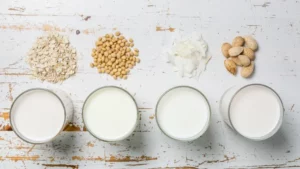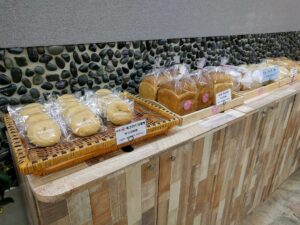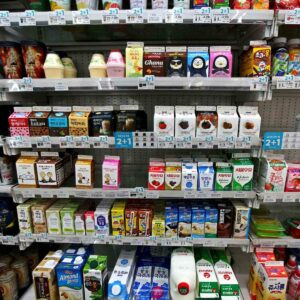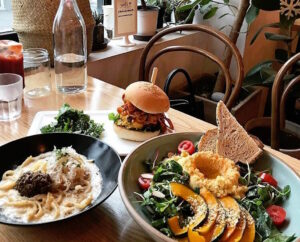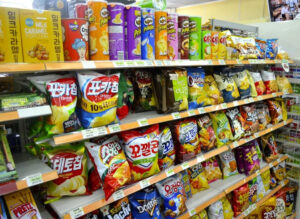Enjoy your stay and don’t stress about restrictions!
Traveling abroad is an amazing experience, but sometimes it can be quite tricky when you want to enjoy local food but have dietary restrictions. In a country where diary and gluten are prevalent ingredients in many traditional dishes, finding suitable alternatives can seem challenging. However, we unveiled, for you, dairy-free and gluten-free delights waiting to be discovered across Seoul.
Here is our food guide!
DIARY FREE OPTIONS
1. MILK (cafés)
Dairy-free culture and trends in Korea change all the time. Because Koreans love new things, they’re very welcoming to new flavors and mix, especially concerning the coffee culture.
You’ll find that the most common milks in Korea are soy, almond, coconut and oat. But if you search more, other options are available such as pistachio and rice.
Here are some cafés where you can enjoy those delicious flavors:
- Peer Coffee Roasters (almond and soy)
Address: Hannam-dong, Yongsan-gu
- Café Orienté (pistachio)
Address: Hannam-dong, Yongsan-gu
- Le Cafe (soy)
Address: Noksapyeong, Yongsan-gu
- Coffee Montage (almond and oat)
Address: Seongnae-dong, Gangdong-gu
- Unknown Coffee (almond and soy)
Address: Euljiro
2. FOOD (cafés)
As there are some alternatives to dairy milk in cafés, there are also some others with pastries and sweets that you can find there. Because they’re developing dairy-free drinks, other cafés also propose dairy-free food.
And that’s where it gets amazing because the food still looks good and here’s where to go:
- Petit Ami – bakery (dairy-free and vegan products)
Address: Suwon
- Plant – café (dairy free desserts and sweets)
Address: Itaewon
- The Bread Blue – bakery (dairy-free pastries)
Address: Multiple locations
3. BEVERAGES AND FOOD (convenience store)
If during your stay in Korea you prefer enjoying dairy-free products in your accommodation, you can still go to the nearest convenience store you see and buy what you like! They propose various options for dairy-free drinks (milk), and food (ice-cream and more).
Here’s what to enjoy and what products you can search for:
- Maeil (Soy milk products)
- Vegemil Soymilk (Soy milk products)
- Almond Breeze (Almond milk products)
- Vita Coco (Coconut water products)
You can find these alternatives as well in some convenience stores:
- 두유 – soy milk
- 알만드 우유 – almond milk
- 호두 우유 – walnut milk
GLUTEN FREE OPTIONS
1. CAFÉS
Gluten-free cafés can be pretty easy to find in Korea. Even if you cannot find many alternatives in some of them, you always have gluten-free bread and sweets! Because those cafés are becoming quite popular, it’s easy to spot them or even find them on the internet.
But if you wish for something local and with different choice, here you go:
- Sunny Bread – bakery (gluten-free pastries)
Address: Yongsan
- OOH! Breado Bakery – bakery (gluten-free pastries)
Address: Mapo
- Snack Room – dessert shop (gluten-free pastries)
Address: Yeongdeungpo
2. RESTAURANTS
Spending some time at cafés to enjoy some sweets is nice but how about having lunch or dinner? It is more common to see gluten-free cafés or snacks than real meals that will make you full.
We digged into this area and we’re here to provide you with some restaurants:
- Vegetus – vegan restaurant (gluten-free and vegan food)
Address: Yongsan
- Ssaltongdak – restaurant (gluten-free option)
Address: Dangsan
- Buddha’s Belly – Thai restaurant (gluten-free option)
Address: Noksapyeong
- 853 – Korean BBQ restaurant (gluten-free option)
Address: Jongno
- The Park View – restaurant (gluten-free option)
Address: Jung-gu
- Akira Back – restaurant (gluten-free dedicated)
Address: Jung-gu
3. SNACKS (convenience store)
- Potato chip (포카칩)
- Doritos Nacho Cheese (red package)
- Jagabee Chips (자가비 – green package)
- Rice Chips (쌀로 – pink package)
- Corn Chips (콘칲 군옥수수맛)
- Meiji Macadamia Chocolate
DISCLAIMER:
In Korean cuisine there are three widely used ingredients to watch out for if you need to eat gluten-free in Korea. They are soy sauce (간장, ganjang), chili paste (고추장, gochujang) and soybean paste (된장, dwenjang). They are found very often indeed in various Korean dishes, and so, just to be on the safe side, if you go to a restaurant in Korea you can always specify that you cannot eat them.
Enjoy the food and remember to be careful when you want to eat in some restaurants!!
By Alice DUPLACIEUX & Tya BÉRAMICE-DRACAN


